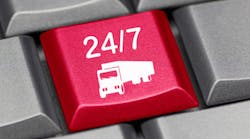Digital Freight Matching and the New Era of Freight Logistics
Today’s freight logistics industry is beginning to undergo a major transformation—acceleration and really a reinvention, thanks to new digital technologies designed to drive efficiencies. Foresighted shippers and truck drivers are adopting these solutions to gain a competitive edge now and in the years ahead. Are you being left behind?
Several dynamics are driving the change. Big Data is providing companies with an unprecedented amount of actionable market intelligence. The Internet of Things is increasingly connecting people 24/7 with all types of devices, networks, vehicles and more.
Meanwhile, e-commerce continues to grow, forecast to reach more than $500 billion domestically by 2020, according to Forrester, a technology and market research company. Online selling has spawned a new breed of “get-it-to-me-now” customers who expect to receive merchandise and services in near-real-time, overnight or, worst case, in two days. So rapid omni-channel consumer goods delivery has become a competitive differentiator.
To compete successfully in this world, shippers and the drivers they rely on have to be more agile and efficient than ever. That requires an alternative to legacy, typically cumbersome, manual methods that shippers traditionally have used to find and secure reliable carrier capacity in the highly fragmented, $800 billion transportation industry.
These methods include contacting multiple carriers and managing just-in-time requests for quotes or using transportation brokers, third-party logistics providers and load boards—all of which entail back-and-forth phone calling and e-mailing. This situation has inspired a number of technology companies to develop a new category of on-demand, software solutions referred to as digital freight matching (DFM). DFM is gaining traction because it addresses key pain points for both shippers and drivers.
DFM lets shippers directly and almost immediately find drivers with capacity to transport their truckload, partial truckload and less-than-truckload freight on the right types of trucks on the dates and routes they need. Shippers get competitive and transparent rates upfront and can track in-transit and delivery details so they always know the status of their shipments.
DFM also eliminates the protracted processes and added costs inherent in working through middlemen. Brokers, for example, can charge hefty commissions—“as much as 45% of the delivery cost per load for short-haul trips,” according to a March 2016 story in The Economist. This eats into shippers’ profits, which could otherwise be reinvested into their core business.
There’s a huge upside, too, for drivers. DFM platforms can offer “know-before-you-go” visibility so a trucker knows upfront whether there’s a load at the drop off, decreasing the odds that he will drive home with an empty, or non-revenue generating, truck. Historically, this has been a big problem. “Every year American [trucks] travel empty for 50 billion miles,” or 28% of their total mileage, according to The Economist.
Another advantage is fast payment. DFM enables drivers to upload proof-of-delivery confirmations in real-time via a smartphone camera. Shippers benefit by getting better freight rates because truck drivers using DFM have lower working capital requirements.
But this is only the beginning of DFM. Experts predict a not-so-distant future that sounds like science fiction. According to a September 2016 report by Strategy&, a global strategy consulting firm that is part of PwC, “Trucks will eventually be able to determine whether they can take on additional freight. The truck trailer itself will be able to determine through sensors its available space and weight, as well as scheduled route, ETA and other relevant information, and communicates this data to a digital freight-matching platform.
“In turn, the platform will notify the driver and fleet management about available freight-sharing opportunities, and an agreement can be struck between the truck operator and the shipper. Ultimately, with the aid of smart cloud-based solutions, goods sitting in a warehouse equipped with their own communication chips will be able to contact trucks directly to find their own transportation to their intended destination.”
Although industry analysts say this scenario is at least a decade away, clearly it’s no longer business-as-usual for freight logistics. Real-time exchange of information between shippers and truck drivers is becoming as important as the actual transportation of goods.
Andrew Kelley is president of haulme, a transportation marketplace that connects shippers and truck drivers on-demand.



